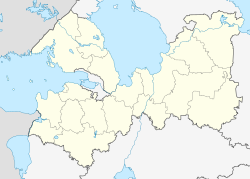Kexholm
| Priozersk (English) Приозерск (Russian) |
|
|---|---|
| - Town - | |
 Priozersk railway station |
|
 Location of Leningrad Oblast in Russia |
|
|
|
|
|
|
|
|
|
|
| Administrative status (as of June 2013) | |
| Country | Russia |
| Federal subject | Leningrad Oblast |
| Administrative district | Priozersky District |
| Settlement municipal formation | Priozerskoye Settlement Municipal Formation |
| Administrative center of | Priozersky District, Priozerskoye Settlement Municipal Formation |
| Municipal status (as of June 2013) | |
| Municipal district | Priozersky Municipal District |
| Urban settlement | Priozerskoye Urban Settlement |
| Administrative center of | Priozersky Municipal District, Priozerskoye Urban Settlement |
| Statistics | |
| Population (2010 Census) | 18,933 inhabitants |
| Time zone | MSK (UTC+03:00) |
| Previous names | Keksgolm (until October 1, 1948) |
| Postal code(s) | 188760, 188761 |
| on | |
Priozersk (Russian: Приозе́рск, known before 1948 in Finnish as Käkisalmi (Swedish: Kexholm) is a town and the administrative center of Priozersky District in Leningrad Oblast, Russia, located at the northwestern shore of Lake Ladoga, at the estuary of the northern armlet of the Vuoksi River on the Karelian Isthmus. It is served by a station of the same name on the St. Petersburg—Khiytola railway. Population: 18,933 (2010 Census);20,506 (2002 Census);20,557 (1989 Census).
The main landmark of Priozersk, the Korela Fortress, has historically been the center for the Karelians of the Karelian Isthmus and from time to time the northwestern outpost of the realm of the Russians or the eastern outpost of the realm of the Swedes.
From the Middle Ages, Priozersk was known as Korela to Russians and Käkisalmi to Karelians and Finns. The town was a part of Vodskaya pyatina of the Novgorod Republic. Novgorod taxation documents from 1500 list 183 houses in Korela, suggesting an estimated population of 1,500–2,000. The Swedes captured Korela twice: in 1578 for seventeen years and in 1611 for a hundred years. In the Swedish Empire, the fortress was called Kexholm and the whole region became known as the County of Kexholm. Russia definitively secured the area during the Great Northern War; the town's Swedish name was retained, however, as Keksgolm (Кексгольм). Unfortunately, wars and devastating fires in 1300, 1580, 1634, and 1679 took their toll on the civilian population. Consequently, when the town gained its first court house in 1800, the population was only 400.
...
Wikipedia


